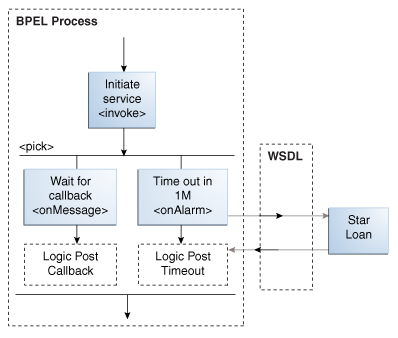Selecting Between Continuing or Waiting on a Process with a Pick Activity
The pick activity provides two branches, each one with a condition. The branch that has its condition satisfied first is executed. In the following example, one branch's condition is to receive a loan offer, and the other branch's condition is to wait a specified amount of time.
Figure 15-1 provides an overview. The following activities take place (in order of priority):
-
An invoke activity initiates a service, in this case, a request for a loan offer from Star Loan.
-
The pick activity begins next. It has the following conditions:
-
onMessage
This condition has code for receiving a reply in the form of a loan offer from the Star Loan web service. The onMessage code matches the code for receiving a response from the Star Loan web service before a timeout was added.
-
onAlarm
This condition has code for a timeout of one minute. This time is defined as
PT1M, which means to wait one minute before timing out. In this timeout setting:-
Sis for seconds -
Mfor one minute -
His for hour -
Dis for day -
Yis for year
In the unlikely event that you want a time limit of
1year,3days, and15seconds, you enter it asPT1Y3D15S. The remainder of the code sets the loan variables selected and approved tofalse, sets the annual percentage rate (APR) at0.0, and copies this information into theloanOffervariable.The time duration format is specified by the BPEL standard. For more detailed information on the time duration format, see the duration section of the most current XML Schema Part 2: Datatypes document at:
http://www.w3.org/TR/xmlschema-2/#duration -
-
-
The pick activity condition that completes first is the one that the BPEL process service component executes. The other branch is not executed.
An onMessage branch is similar to a receive activity in that it receives messages. However, you can define a pick activity with multiple onMessage branches that can wait for similar partner links and port types, but have different operations. Therefore, separate threads and parallel processes can be invoked for each operation. This differs from the receive activity in which there is only one operation. Another difference is that you can create a new instance of a business process with a receive activity (by selecting the Create Instance check box), but you cannot do this with a pick activity.
Note:
You can also create onMessage branches in BPEL 1.1 scope activities and onAlarm branches in BPEL 1.1 and 2.0 scope activities. Expand the Scope activity in Oracle JDeveloper, and browse the icons on the left side to find the branch you want to add.
